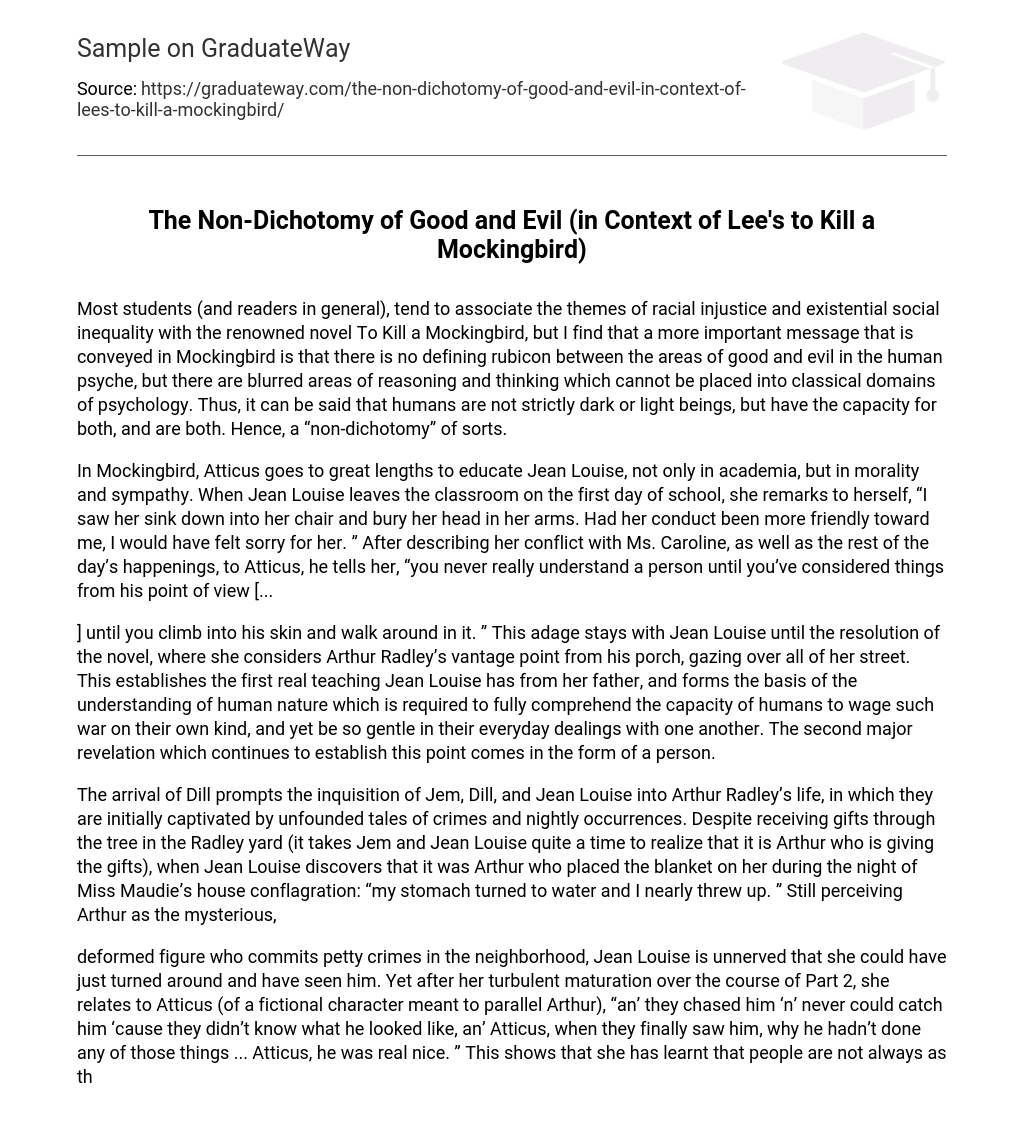Most students (and readers in general), tend to associate the themes of racial injustice and existential social inequality with the renowned novel To Kill a Mockingbird, but I find that a more important message that is conveyed in Mockingbird is that there is no defining rubicon between the areas of good and evil in the human psyche, but there are blurred areas of reasoning and thinking which cannot be placed into classical domains of psychology. Thus, it can be said that humans are not strictly dark or light beings, but have the capacity for both, and are both. Hence, a “non-dichotomy” of sorts.
In Mockingbird, Atticus goes to great lengths to educate Jean Louise, not only in academia, but in morality and sympathy. When Jean Louise leaves the classroom on the first day of school, she remarks to herself, “I saw her sink down into her chair and bury her head in her arms. Had her conduct been more friendly toward me, I would have felt sorry for her. ” After describing her conflict with Ms. Caroline, as well as the rest of the day’s happenings, to Atticus, he tells her, “you never really understand a person until you’ve considered things from his point of view […
] until you climb into his skin and walk around in it. ” This adage stays with Jean Louise until the resolution of the novel, where she considers Arthur Radley’s vantage point from his porch, gazing over all of her street. This establishes the first real teaching Jean Louise has from her father, and forms the basis of the understanding of human nature which is required to fully comprehend the capacity of humans to wage such war on their own kind, and yet be so gentle in their everyday dealings with one another. The second major revelation which continues to establish this point comes in the form of a person.
The arrival of Dill prompts the inquisition of Jem, Dill, and Jean Louise into Arthur Radley’s life, in which they are initially captivated by unfounded tales of crimes and nightly occurrences. Despite receiving gifts through the tree in the Radley yard (it takes Jem and Jean Louise quite a time to realize that it is Arthur who is giving the gifts), when Jean Louise discovers that it was Arthur who placed the blanket on her during the night of Miss Maudie’s house conflagration: “my stomach turned to water and I nearly threw up. ” Still perceiving Arthur as the mysterious,
deformed figure who commits petty crimes in the neighborhood, Jean Louise is unnerved that she could have just turned around and have seen him. Yet after her turbulent maturation over the course of Part 2, she relates to Atticus (of a fictional character meant to parallel Arthur), “an’ they chased him ‘n’ never could catch him ‘cause they didn’t know what he looked like, an’ Atticus, when they finally saw him, why he hadn’t done any of those things … Atticus, he was real nice. ” This shows that she has learnt that people are not always as they seem, and that characters in real life are not often so plain cut.
The hypocrisy of the missionary ladies, as well as Ms. Caroline, in their frenzied worry of Hitler and the Mrunas, neglect the mistreatment occurring in their own communities, also reflect this point which is being made. Jean Louise’s acceptance of this is shown in this quote: “Aunt Alexandra looked across the room at me and smiled. [… ] After all, if Aunty could be a lady in a time like this, so could I. ” The context of this quote is that Atticus has just informed Aunt Alexandra and Jean Louise of Tom Robinson’s death, directly after Mrs.
Merriweather’s insulting harangue against Tom Robinson. Aunty is initially distraught, but after being comforted by Miss Maudie, they rejoin the ladies at the table. These three major occurrences help to shape Jean Louise’s maturation during the novel, or rather, help to relate to the reader her maturation. These three events collectively establish a powerful message that defines the novel, in that humans, as sentient beings – and as people, have the capacity – the ability, to do both good, and terrible evil.





